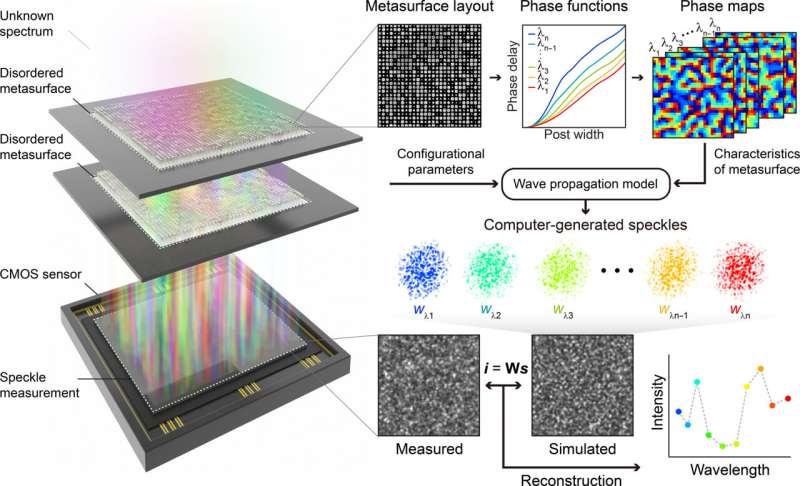Smartphones may no longer be just communication devices, they’re evolving into powerful scientific tools, thanks to the arrival of high-resolution spectrometer technology that can fit right inside your device. This technology lets users analyze materials, monitor health, and even conduct scientific experiments, all with the convenience of a handheld device.
What Makes These Spectrometers Stand Out?
- Compact Integration: Modern spectrometers have been miniaturized to potentially fit into smartphones.
- High Resolution: Users can expect detailed, accurate analyses that previously required bulky laboratory equipment.
- User-Friendly Experience: Intuitive apps and interfaces ensure anyone can perform advanced analyses, regardless of their scientific background.
- Versatile Use Cases: Applications range from environmental monitoring and food safety to health diagnostics and educational experiments.
Schematic of reconstructive spectrometer based on double-layer disordered metasurfaces.
How Does Smartphone Spectrometry Work?
These compact devices use micro-optics and advanced sensors to capture and separate light into its component wavelengths. Once the data is collected, the phone’s processor interprets it, delivering instant results or feedback directly to the user with no additional tools required.
What Are MetaSurfaces?
Metasurfaces are ultrathin structures that manipulate light in novel ways. They're composed of nanoscale elements, each smaller than the wavelength of light, allowing for precise control over light's phase, amplitude, and direction.
By manipulating light at the nanoscale, these surfaces create unique speckle patterns for each wavelength. In reconstructive spectrometers, these speckle patterns are analyzed to reconstruct the spectral information of the light, transforming smartphones into powerful scientific tools.
Wider Impact on Science and Society
By integrating spectrometers into smartphones, access to scientific analysis becomes democratized. Students, researchers, and everyday consumers can now conduct real-time investigations outside the lab. This leap in convenience and accessibility is poised to fuel further innovation in mobile health, environmental monitoring, and beyond.
Challenges to Overcome
- Calibration: Ensuring accuracy across the wide range of smartphone models and operating environments poses ongoing technical challenges.
- Cost Considerations: While advanced components might increase device costs initially, broader adoption is expected to drive these prices down over time.
- Data Privacy: Collecting sensitive health or environmental data requires robust privacy protections to safeguard user information.
Takeaway
High-resolution smartphone spectrometers are transforming how we interact with our environment. Their blend of mobility, precision, and ease of use empowers users to make informed decisions wherever they are. As this technology advances, expect even more innovative applications and greater accessibility in the years ahead.
Read the paper on Science.org https://www.science.org/doi/10.1126/sciadv.adv2376


High-Resolution Spectrometers Are Transforming Smartphones Into Scientific Powerhouses